Cooperative Multi-Objective Optimization of DC Multi-Microgrid Systems in Distribution Networks
Abstract
:Featured Application
Abstract
1. Introduction
- A grid-connected MMGS containing RESs and EVs is constructed, where RESs, EVs, MGs and distribution networks are combined, bidirectional V2G technology is used and the across-time-and-space energy transmission (ATSET) of EVs is thoroughly considered. The effect of the across-time-and-space energy transmission on MMGS economic operation is analyzed to state the potential benefits of cooperative multi-objective optimization.
- A cooperative multi-objective optimization model is established, including the dynamic economic dispatch of RESs, EVs, DC/AC converters, and the reactive power optimization of DC/AC converters in MMGS. The cooperative multi-objective optimization model consists of two loops. The inner-loop model uses the active power output of RESs, EVs, DC/AC converters as variables, and the daily operating cost of MMGS is used as the optimization objective. The outer-loop model uses the reactive power output of the DC/AC converters as the variable to optimize the network loss of the distribution network, thereby reducing network loss cost and carbon emissions cost. The ultimate goal of the cooperative multi-objective is to obtain the optimal daily economic cost.
- The concepts of carbon neutrality and carbon peaking are combined. Through the cooperative multi-objective optimization model, the carbon emissions generated by the operation of the MMGS and the distribution network are effectively reduced. The cooperative multi-objective optimization model not only improves the economy but also reduces the total carbon emissions of MMGS and the distribution network.
2. System Structure
2.1. Structure of the DC Multi-Microgrid System
2.2. DC Microgrid
2.3. Bidirectional DC/AC Converter
3. Mathematical Model
3.1. Renewable Power Generation
3.1.1. Photovoltaic Module
3.1.2. Wind Turbine
3.2. Electric Vehicles
3.2.1. EVs Model
3.2.2. Across-Time-and-Space Energy Transmission of EV
3.3. EV Charging/Discharging Infrastructures
4. Cooperative Multi-Objective Optimization Model
4.1. Description of the Optimization Model
4.2. Double-Loop Optimization Process
4.3. Cooperative Multi-Objective Optimization Objective Function
4.4. Inner-Loop Optimization
4.4.1. Energy Transaction Cost
4.4.2. Carbon Emissions and Cost
4.5. Constraints of the Inner-Loop Model
4.5.1. EVs Power Constraint
4.5.2. EVs Capacity Constraint
4.5.3. RESs Output Constraint
4.5.4. System Power Balance Constraint
4.6. Outer-Loop Optimization
4.6.1. Network Loss Cost
4.6.2. Carbon Emissions and Cost
4.7. Constraints of the Outer-Loop Model
4.7.1. Node Power Flow Constraint
4.7.2. Node Voltage Constraint
4.7.3. Branch Power Constraint
4.7.4. Branch Current Constraint
4.7.5. Reactive Output Constraint of DC/AC Converter
4.8. Particle Swarm Algorithm
4.8.1. Procedure of PSO
4.8.2. Coding
5. Case Study and Discussion
5.1. Case Description
5.1.1. Case 1
5.1.2. Case 2
5.1.3. Case 3
5.1.4. Case 4
5.2. Simulation System Construction
5.2.1. System Introduction
5.2.2. Parameters of RESs
5.2.3. Parameters of DC/AC Converter
5.2.4. Parameters of EVs
5.2.5. Other Parameters
5.3. Simulation Results
5.3.1. Inner-Loop Optimization Results
- Case 1
- 2.
- Case 2
- 3.
- Case 3
5.3.2. Outer-Loop Optimization Results
5.3.3. Cooperative Multi-objective Optimization Results
5.3.4. Further Verification
6. Conclusions
- According to the simulation results, the economic dispatch model of the inner-loop in the cooperative multi-objective optimization can reduce the operating cost of MMGS, which makes full use of the ATSET of EVs. Additionally, the optimization of the output reactive power output of the DC/AC converters of the outer-loop can reduce network loss cost and carbon emissions cost of the distribution network. The two cooperate to realize the improvement of the economy of MMGS and the efficient operation of the distribution network.
- The cooperative multi-objective optimization model not only realizes the optimization of the economic cost of MMGS and the network loss of the distribution network, but also reduces the total carbon emissions of MMGS and the distribution network, which greatly responds to the calls for national carbon neutrality and carbon peak.
Author Contributions
Funding
Institutional Review Board Statement
Informed Consent Statement
Data Availability Statement
Conflicts of Interest
Nomenclature
| Bij | Susceptance of branch ij in the distribution network. |
| CETC | Economic total cost of MMGS. |
| COTC | Operating total cost of MMGS from the inner-loop model. |
| CWTC | Energy loss cost of the MMGS from the outer-loop model. |
| Cil | Network loss cost. |
| Cco | Carbon emissions cost. |
| COCm | Operating cost of the m-th MG from the inner-loop model. |
| Cexm | Energy transaction cost in the m-th MG. |
| Ccim | Carbon emissions cost in the m-th MG. |
| Cresm | Cost of RESs of the m-th MG. |
| CPVm | Cost of PVs in the m-th MG. |
| CWTm | Cost of WTs in the m-th MG. |
| PV power generation cost in the m-th MG in the t-th hour. | |
| WT power generation cost in the m-th MG in the t-th hour. | |
| Cevm | Cost of energy exchange between the m-th MG and EVs. |
| Charging price of EVs in m-th MG in the t-th hour. | |
| Discharging price of EVs in m-th MG in the t-th hour. | |
| Cgm | Energy exchange cost between the m-th MG and the distribution network. |
| Electricity price that m-th MG purchases/sells to the distribution network in the t-th hour. | |
| Ccym | Additional cycle cost of EV batteries in m-th MG. |
| Additional battery charging/discharging cycle cost of n-th EV. | |
| EC | Total carbon emissions of MMGS and the distribution network. |
| ECim | Carbon emissions generated by m-th MG in the inner-loop model. |
| ECO | Carbon emissions in the outer-loop model. |
| ec | Carbon emissions factor. |
| f | The main objective function of the cooperative optimization model. |
| f1 | The objective functions of the inner-loop model. |
| f2 | The objective functions of the outer-loop model. |
| Gij | Conductance of branch ij in the distribution network. |
| Upper limit of branch ij current carrying capacity in the distribution network. | |
| i,j | Nodes of the distribution network. |
| kil | Loss cost coefficient. |
| kc | Carbon cost factor. |
| kcy | Number of additional charging/discharging cycles. |
| ki | The state variable of the i-th branch switch. |
| M | Number of MGs in the MMGS. |
| N | Number of EVs in m-th MG. |
| Nbr | Number of branches in the distribution network. |
| Exchanging power in the t-th hour of the n-th EV in the m-th MG. | |
| Exchanging power in the t-th hour of the EVs in the m-th MG. | |
| Power of the EVCDIs of the n-th EV in the m-th MG in the t-th hour. | |
| Power output of PVs in the m-th MG in the t-th hour. | |
| power output of WTs in the m-th MG in the t-th hour. | |
| Active power output between the m-th MG and the distribution network in the t-th hour through the DC/AC converters. | |
| Rated power of the EVCDI serving the n-th EV in the m-th MG. | |
| Total load of the m-th MG in the t-th hour. | |
| Pij,t | Active power of branch ij in the t-th hour. |
| Initially active power of branch ij when connected without MG in the t-th hour. | |
| Initial input active power of node i in the t-th hour. | |
| PLi,t | Active load of node i in the t-th hour. |
| Pij,max | Maximum active power of the branch ij. |
| Qij,t | Reactive power of branch ij in the t-th hour. |
| Initially reactive power of branch ij when connected without MMGS in the t-th hour. | |
| Reactive power output between the m-th MG and the distribution network in the t-th hour through the DC/AC converters. | |
| Initial input reactive power of node i in the t-th hour. | |
| QLi,t | Reactive load of node i in the t-th hour. |
| Qij,max | Maximum reactive power of the branch ij. |
| Rij | The resistance of branch ij. |
| SOCEVm,n,t | Remaining power capacity of the n-th EV in the m-th MG in the t-th hour. |
| SOCEVm,n,min | Minima capacity, respectively, of the n-th EV in the m-th MG. |
| SOCEVm,n,max | Maximum capacity, respectively, of the n-th EV in the m-th MG. |
| Sm | Rated power of the DC/AC converter in the m-th MG. |
| T | Scheduling cycle, one day, 24 h. |
| Vij,t | Voltage of branch ij in the t-th hour. |
| Lower limits of the node i voltage amplitude. | |
| Upper limits of the node i voltage amplitude. | |
| Original baseline network loss. | |
| Total daily operating network loss of the distribution network. | |
| Daily operating increased network loss of the distribution network. | |
| σ | Self-discharge coefficient of EV’s battery. |
| ∆t | Length of the time slot set for the optimization. |
| ηDEV | Efficiency for EV discharging. |
| ηCEV | Efficiency for EV charging. |
| δij | Phase angle difference of branch ij. |
References
- Chan, C.; Zhou, G.Y.; Zhang, D. Intelligent energy ecosystem based on carbon neutrality. In Proceedings of the 2017 IEEE Conference on Energy Internet and Energy System Integration (EI2), Beijing, China, 26–28 November 2017; pp. 1–5. [Google Scholar]
- Wang, X.; Barnett, A. The evolving value of photovoltaic module efficiency. Appl. Sci. 2019, 9, 1227. [Google Scholar] [CrossRef] [Green Version]
- Li, H.; Ye, Y.; Lin, L. Low-Carbon Economic Bi-Level Optimal Dispatching of an Integrated Power and Natural Gas Energy System Considering Carbon Trading. Appl. Sci. 2021, 11, 6968. [Google Scholar] [CrossRef]
- Izquierdo-Monge, O.; Peña-Carro, P.; Villafafila-Robles, R.; Duque-Perez, O.; Zorita-Lamadrid, A.; Hernandez-Callejo, L. Conversion of a Network Section with Loads, Storage Systems and Renewable Generation Sources into a Smart Microgrid. Appl. Sci. 2021, 11, 5012. [Google Scholar] [CrossRef]
- Saponara, S.; Saletti, R.; Mihet-Popa, L. Hybrid micro-grids exploiting renewables sources, battery energy storages, and bi-directional converters. Appl. Sci. 2019, 9, 4973. [Google Scholar] [CrossRef] [Green Version]
- Van Der Meer, D.; Mouli, G.R.C.; Mouli, G.M.-E.; Elizondo, L.R.; Bauer, P. Energy management system with PV power forecast to optimally charge EVs at the workplace. IEEE Trans. Ind. Inform. 2018, 14, 311–320. [Google Scholar] [CrossRef] [Green Version]
- Puma-Benavides, D.S.; Izquierdo-Reyes, J.; Calderon-Najera, J.d.D.; Ramirez-Mendoza, R.A. A Systematic Review of Technologies, Control Methods, and Optimization for Extended-Range Electric Vehicles. Appl. Sci. 2021, 11, 7095. [Google Scholar] [CrossRef]
- Ko, K.S.; Han, S.; Sung, D.K. Performance-based settlement of frequency regulation for electric vehicle aggregators. IEEE Trans. Smart Grid 2018, 9, 866–875. [Google Scholar] [CrossRef]
- Alam, M.J.E.; Muttaqi, K.M.; Sutanto, D. Effective utilization of available PEV battery capacity for mitigation of solar PV impact and grid support with integrated V2G functionality. IEEE Trans. Smart Grid 2016, 7, 1562–1571. [Google Scholar] [CrossRef] [Green Version]
- Kisacikoglu, M.C.; Erden, F.; Erdogan, N. Distributed control of PEV charging based on energy demand forecast. IEEE Trans. Ind. Inform. 2018, 14, 332–341. [Google Scholar] [CrossRef] [Green Version]
- Yang, H.; Pan, H.; Luo, F.; Qiu, J.; Deng, Y.; Lai, M.; Dong, Z.Y. Operational planning of electric vehicles for balancing wind power and load fluctuations in a microgrid. IEEE Trans. Sustain. Energy 2017, 8, 592–604. [Google Scholar] [CrossRef]
- Panwar, L.K.; Konda, S.R.; Verma, A.; Panigrahi, B.K.; Kumar, R. Operation window constrained strategic energy management of microgrid with electric vehicle and distributed resources. IET Gener. Transm. Distrib. 2017, 11, 615–626. [Google Scholar] [CrossRef]
- Masrur, M.A.; Skowronska, A.G.; Hancock, J.; Kolhoff, S.W.; McGrew, D.Z.; Vandiver, J.C.; Gatherer, J. Military-based vehicle-to-grid and vehicle-to-vehicle microgrid—System architecture and implementation. IEEE Trans. Transp. Electrif. 2017, 4, 157–171. [Google Scholar] [CrossRef]
- Zou, H.; Mao, S.; Wang, Y.; Zhang, F.; Chen, X.; Cheng, L. A survey of energy management in interconnected multi-microgrids. IEEE Access 2019, 7, 72158–72169. [Google Scholar] [CrossRef]
- Nikmehr, N.; Ravadanegh, S.N. Optimal power dispatch of multi-microgrids at future smart distribution grids. IEEE Trans. Smart Grid 2015, 6, 1648–1657. [Google Scholar] [CrossRef]
- Kaloudas, C.G.; Ochoa, L.F.; Marshall, B.; Majithia, S.; Fletcher, I. Assessing the future trends of reactive power demand of distribution networks. IEEE Trans. Power Syst. 2017, 32, 4278–4288. [Google Scholar] [CrossRef] [Green Version]
- Ganguly, S. Multi-objective planning for reactive power compensation of radial distribution networks with unified power quality conditioner allocation using particle swarm optimization. IEEE Trans. Power Syst. 2014, 29, 1801–1810. [Google Scholar] [CrossRef]
- Syed, I.; Khadkikar, V.; Zeineldin, H.H. Loss reduction in radial distribution networks using a solid-state transformer. IEEE Trans. Ind. Appl. 2018, 54, 5474–5482. [Google Scholar] [CrossRef]
- Bolognani, S.; Zampieri, S. A distributed control strategy for reactive power compensation in smart microgrids. IEEE Trans. Autom. Control 2013, 58, 2818–2833. [Google Scholar] [CrossRef] [Green Version]
- Arefifar, S.A.; Mohamed, Y.A.-R.I. Probabilistic optimal reactive power planning in distribution systems with renewable resources in grid-connected and islanded modes. IEEE Trans. Ind. Electron. 2014, 61, 5830–5839. [Google Scholar] [CrossRef]
- Cho, Y.-W.; Kwon, J.-M.; Kwon, B.-H. Single power-conversion AC--DC converter with high power factor and high efficiency. IEEE Trans. Power Electron. 2014, 29, 4797–4806. [Google Scholar] [CrossRef]
- Sayed, M.A.; Takeshita, T.; Kitagawa, W. Advanced PWM switching technique for accurate unity power factor of bidirectional three-phase grid-tied DC–AC converters. IEEE Trans. Ind. Appl. 2019, 55, 7614–7627. [Google Scholar] [CrossRef]
- Chen, C.; Duan, S.; Cai, T.; Liu, B. Online 24-h solar power forecasting based on weather type classification using artificial neural network. Sol. Energy 2011, 85, 2856–2870. [Google Scholar] [CrossRef]
- Aien, M.; Fotuhi-Firuzabad, M.; Rashidinejad, M. Probabilistic optimal power flow in correlated hybrid wind–photovoltaic power systems. IEEE Trans. Smart Grid 2014, 5, 130–138. [Google Scholar] [CrossRef]
- Quan, H.; Srinivasan, D.; Khosravi, A. Short-term load and wind power forecasting using neural network-based prediction intervals. IEEE Trans. Neural Netw. Learn. Syst. 2014, 25, 303–315. [Google Scholar] [CrossRef]
- Luo, Z.; Song, Y.; Hu, Z.; Xu, Z.; Yang, X.; Zhan, K. Forecasting charging load of plug-in electric vehicles in China. In Proceedings of the 2011 IEEE Power and Energy Society General Meeting, Detroit, MI, USA, 24–28 July 2011; pp. 1–8. [Google Scholar]
- Chen, C.; Xiao, L.; Duan, S.; Chen, J. Cooperative optimization of electric vehicles in microgrids considering across-time-and-space energy transmission. IEEE Trans. Ind. Electron. 2019, 66, 1532–1542. [Google Scholar] [CrossRef]
- Chen, C.; Duan, S. Optimal integration of plug-in hybrid electric vehicles in microgrids. IEEE Trans. Ind. Inform. 2014, 10, 1917–1926. [Google Scholar] [CrossRef]
- Li, Y.; Zou, Y.; Tan, Y.; Cao, Y.; Liu, X.; Shahidehpour, M.; Tian, S.; Bu, F. Optimal stochastic operation of integrated low-carbon electric power, natural gas, and heat delivery system. IEEE Trans. Sustain. Energy 2018, 9, 273–283. [Google Scholar] [CrossRef]
- Zhang, T.; Yu, L. Optimal allocation of DSTATCOM considering the uncertainty of photovoltaic systems. IEEJ Trans. Electr. Electron. Eng. 2020, 15, 355–363. [Google Scholar] [CrossRef]
- Chen, C.; Chen, J.; Wang, Y.; Duan, S.; Cai, T.; Jia, S. A price optimization method for microgrid economic operation considering across-time-and-space energy transmission of electric vehicles. IEEE Trans. Ind. Inform. 2020, 16, 1873–1884. [Google Scholar] [CrossRef]
- Saha, S.; Banerjee, S.; Maity, D.; Chanda, C. Optimal sizing and location determination of distributed generation in distribution networks. In Proceedings of the 2015 International Conference on Energy, Power and Environment: Towards Sustainable Growth (ICEPE), Shillong, India, 12–13 June 2015; pp. 1–5. [Google Scholar]
- Yang, J.; He, Z.; Ke, J.; Xie, M. A new hybrid multilevel DC–AC converter with reduced energy storage requirement and power losses for HVDC applications. IEEE Trans. Power Electron. 2018, 34, 2082–2096. [Google Scholar] [CrossRef]
- Chen, J.; Chen, C.; Duan, S. Cooperative optimization of electric vehicles and renewable energy resources in a regional multi-microgrid system. Appl. Sci. 2019, 9, 2267. [Google Scholar] [CrossRef] [Green Version]
- Bocca, A.; Baek, D. Optimal Life-Cycle Costs of Batteries for Different Electric Cars. In Proceedings of the 2020 AEIT International Conference of Electrical and Electronic Technologies for Automotive (AEIT AUTOMOTIVE), Turin, Italy, 18–20 November 2020; pp. 1–6. [Google Scholar]
- Yang, H.; Zhou, W.; Lu, L.; Fang, Z. Optimal sizing method for stand-alone hybrid solar–wind system with LPSP technology by using genetic algorithm. Sol. Energy 2008, 82, 354–367. [Google Scholar] [CrossRef]
- Xu, K.; Wang, S.; Zhao, J.; Dou, X.; Zhang, P. Research on Microgrid Dispatch Considering the Charge and Discharge Strategy of Electric Vehicles. In Proceedings of the 2020 12th IEEE PES Asia-Pacific Power and Energy Engineering Conference (APPEEC), Nanjing, China, 20–23 September 2020; pp. 1–5. [Google Scholar]
- Li, Z.; Lu, Q.; Fu, Y. State-splitting multi-objective dynamic programming algorithm for dynamic reconfiguration of active distribution network. Proc. CSEE 2019, 39, 5025–5036. [Google Scholar]

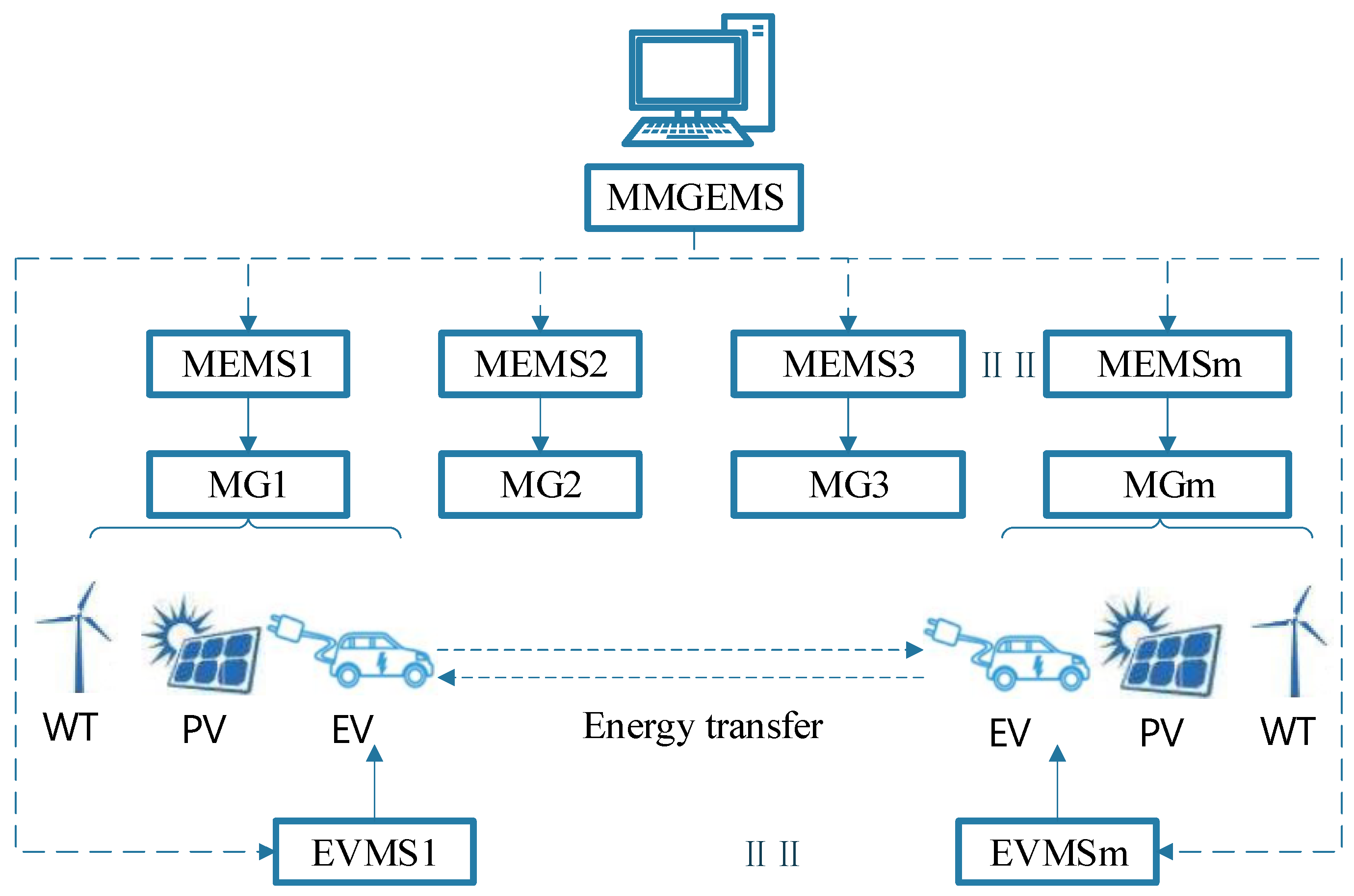
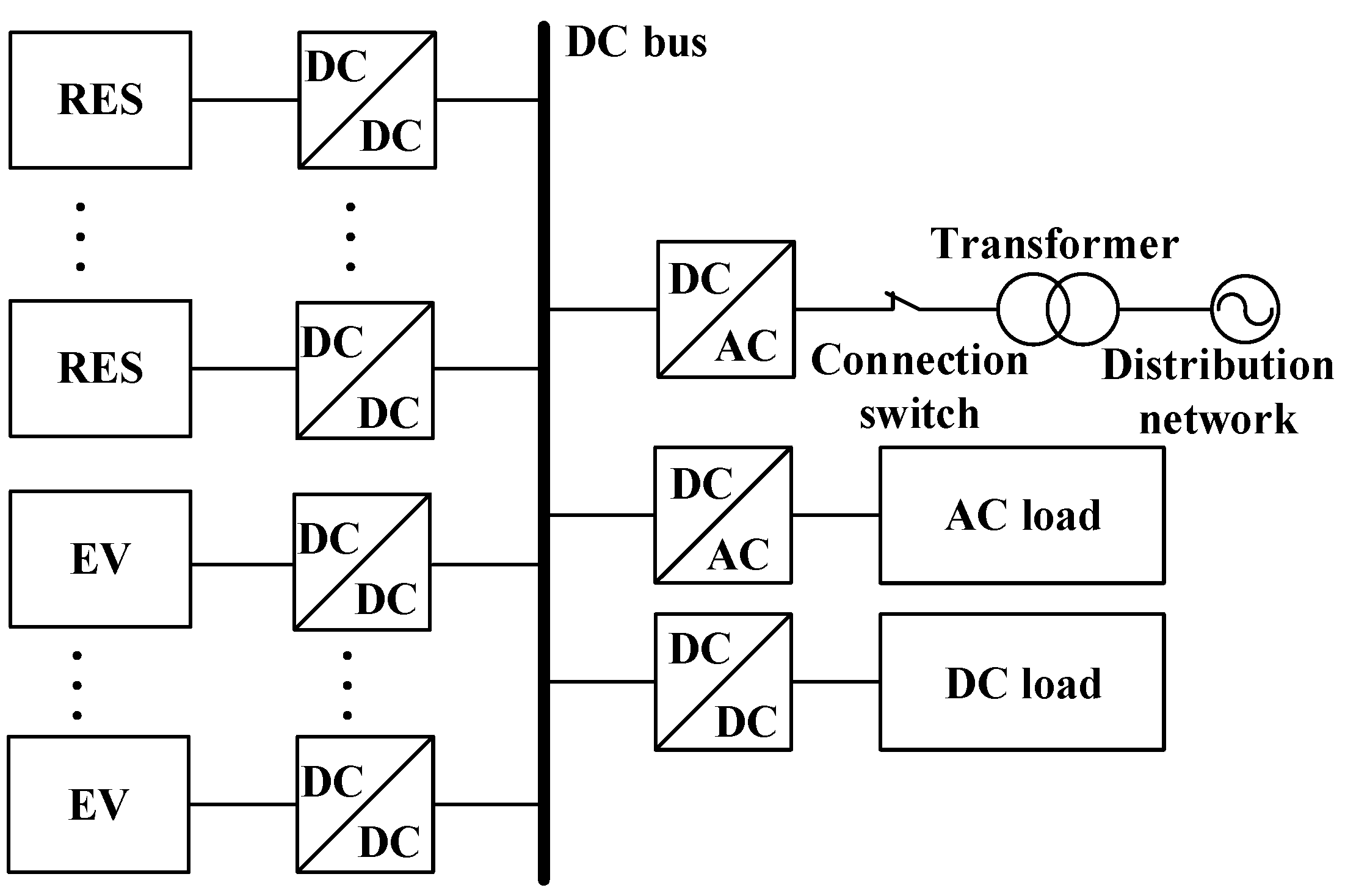
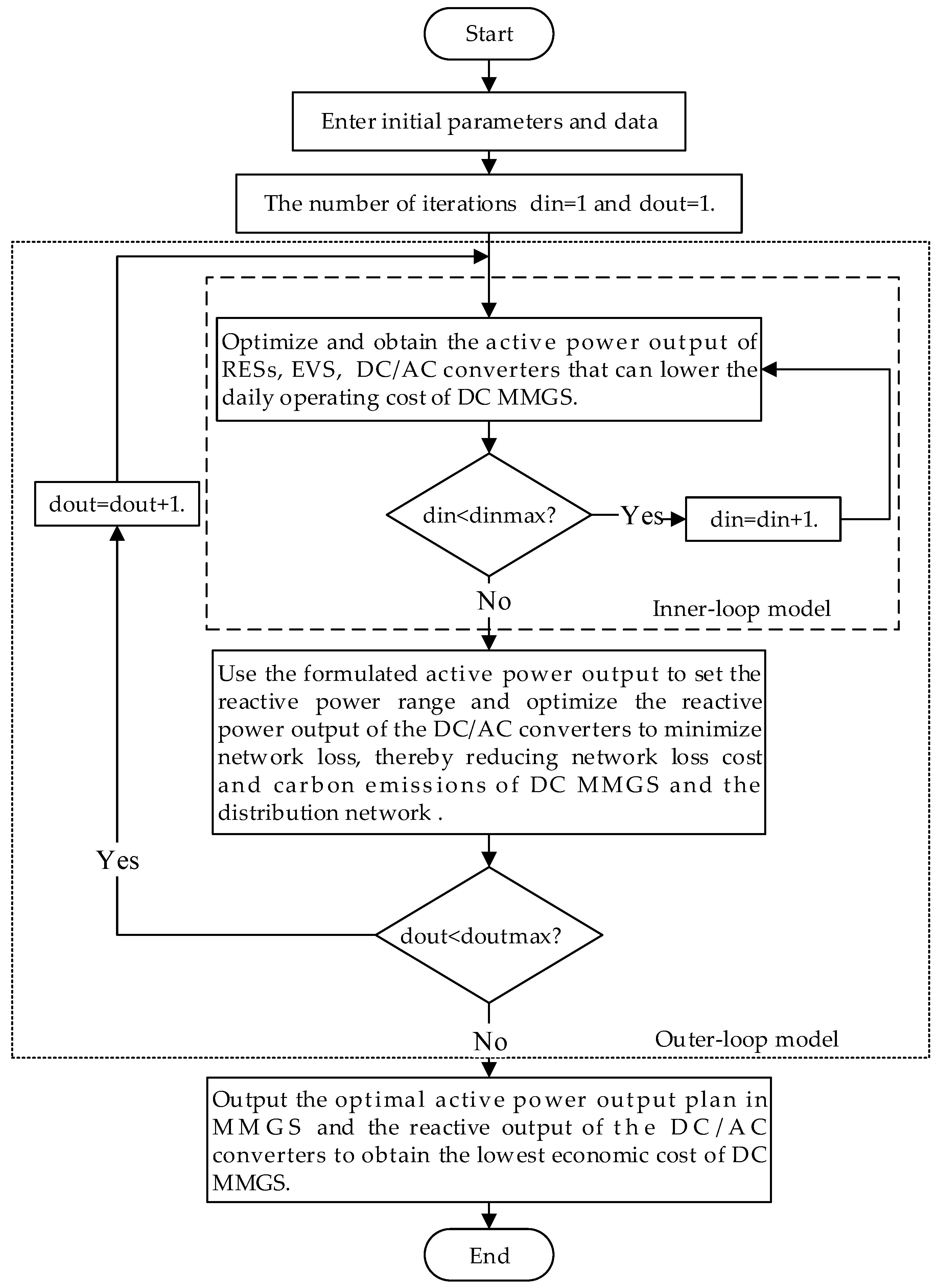
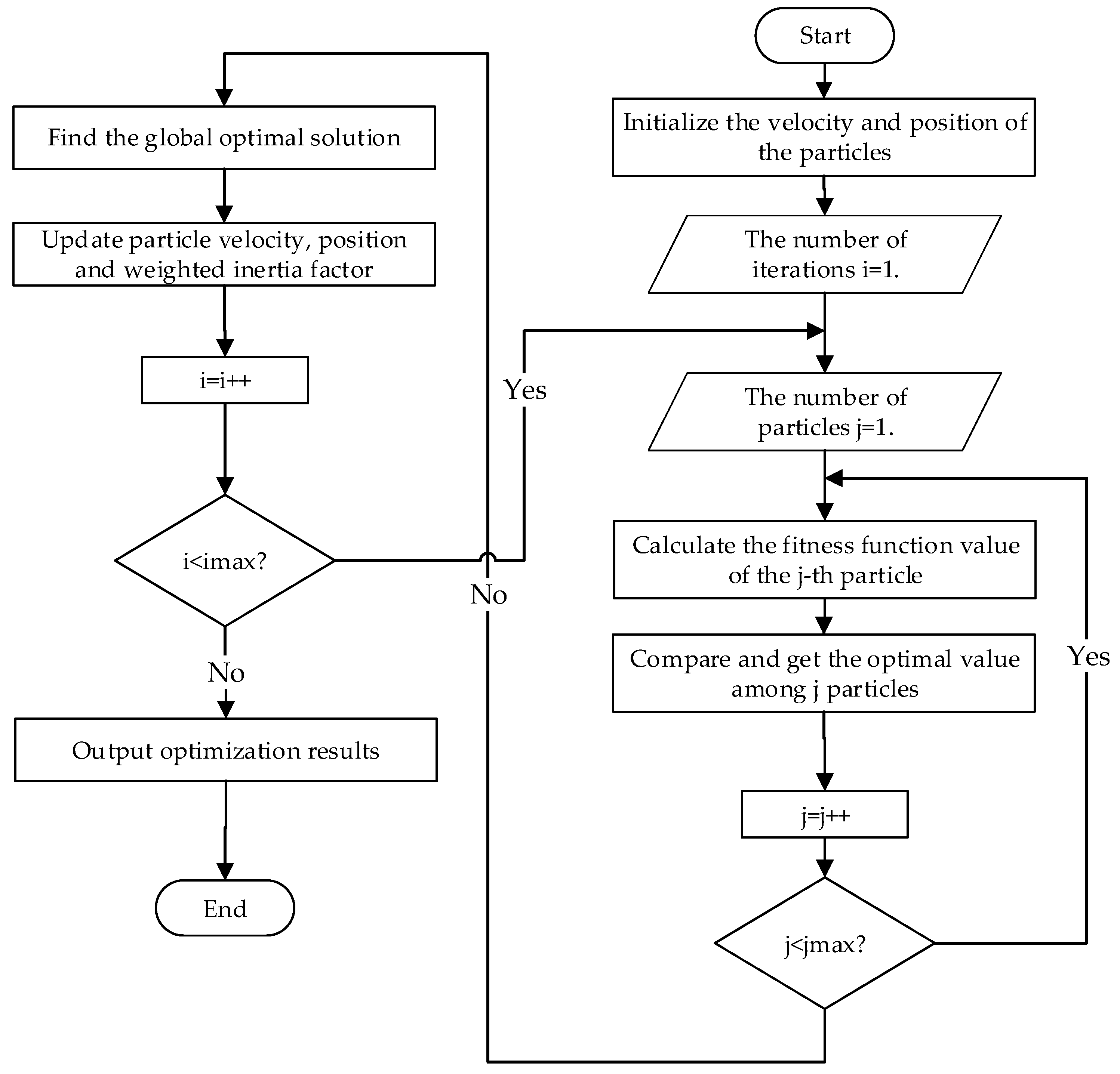
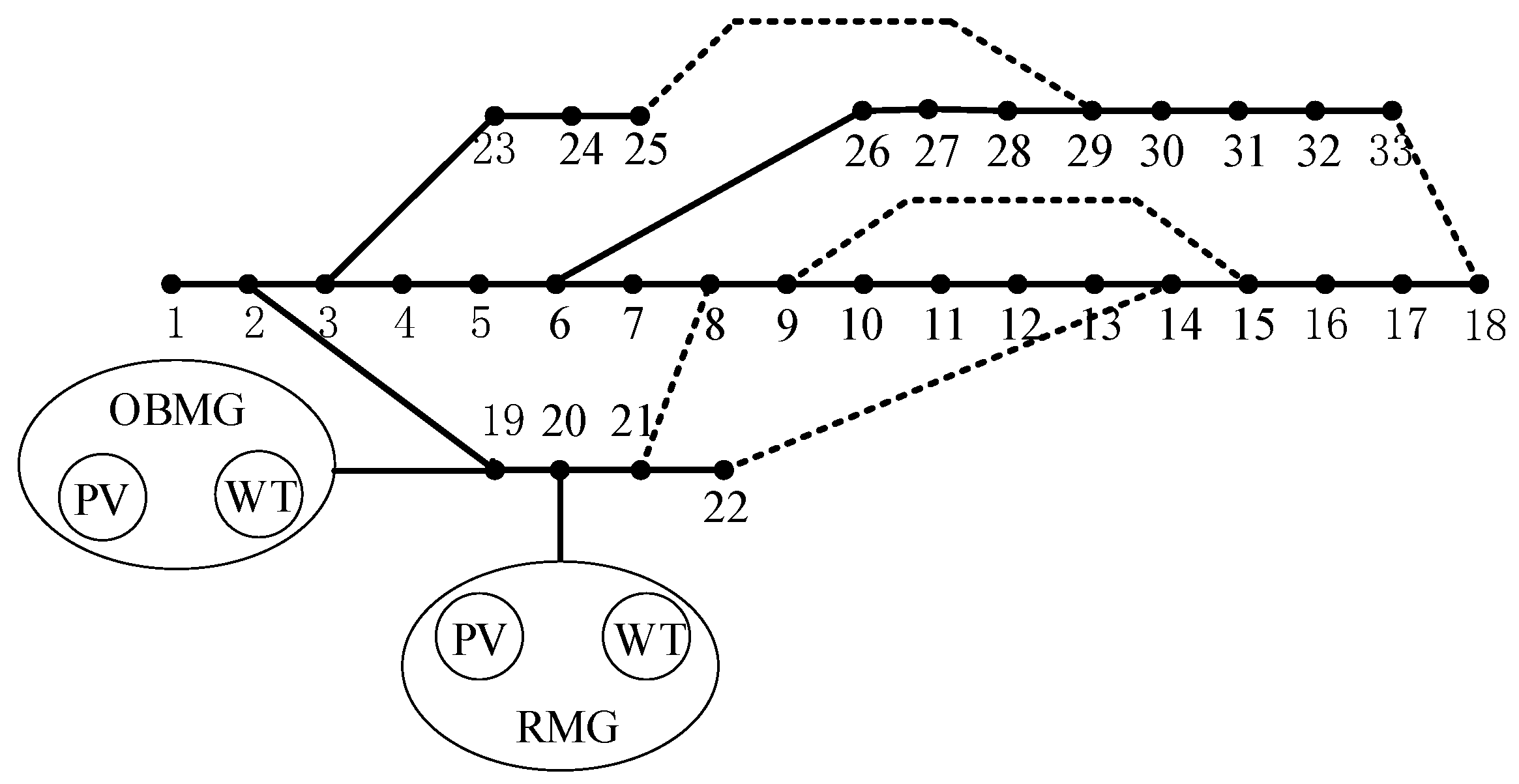
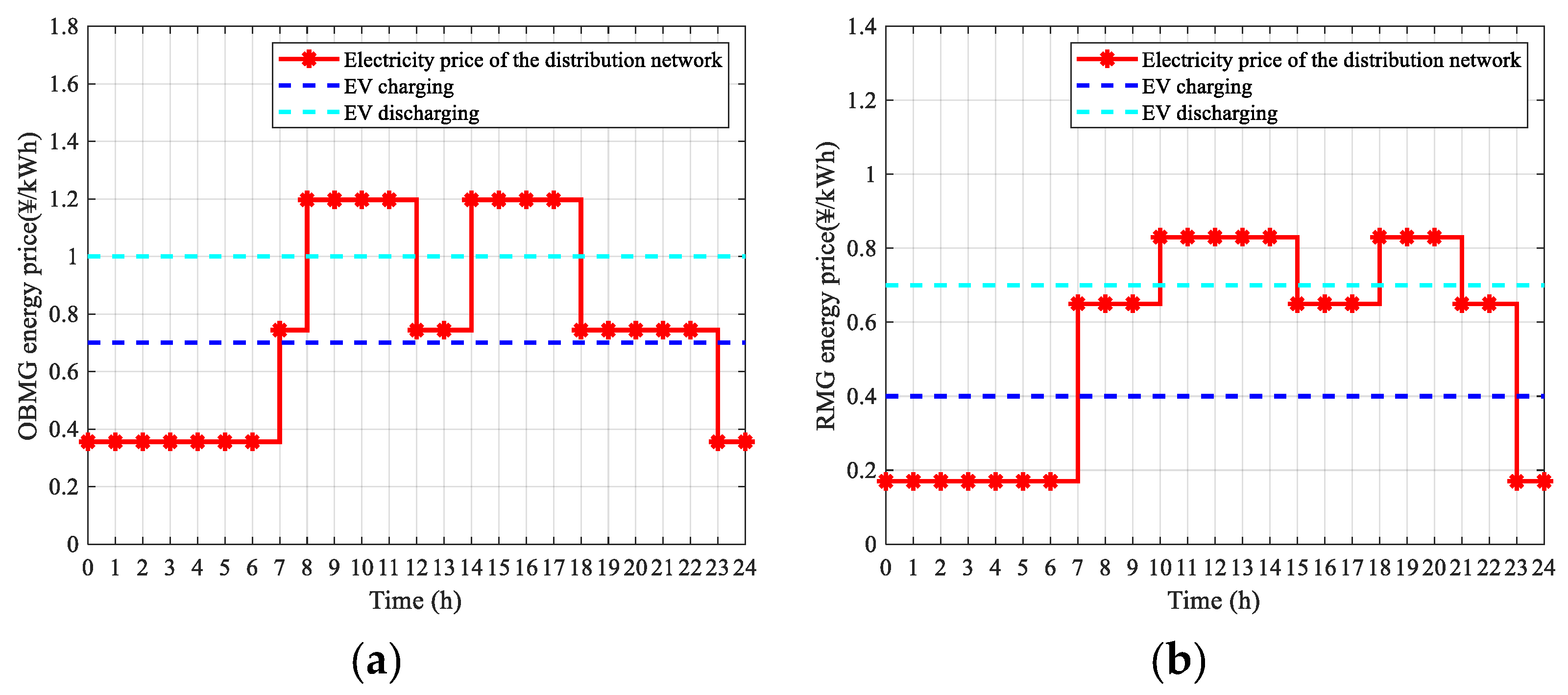
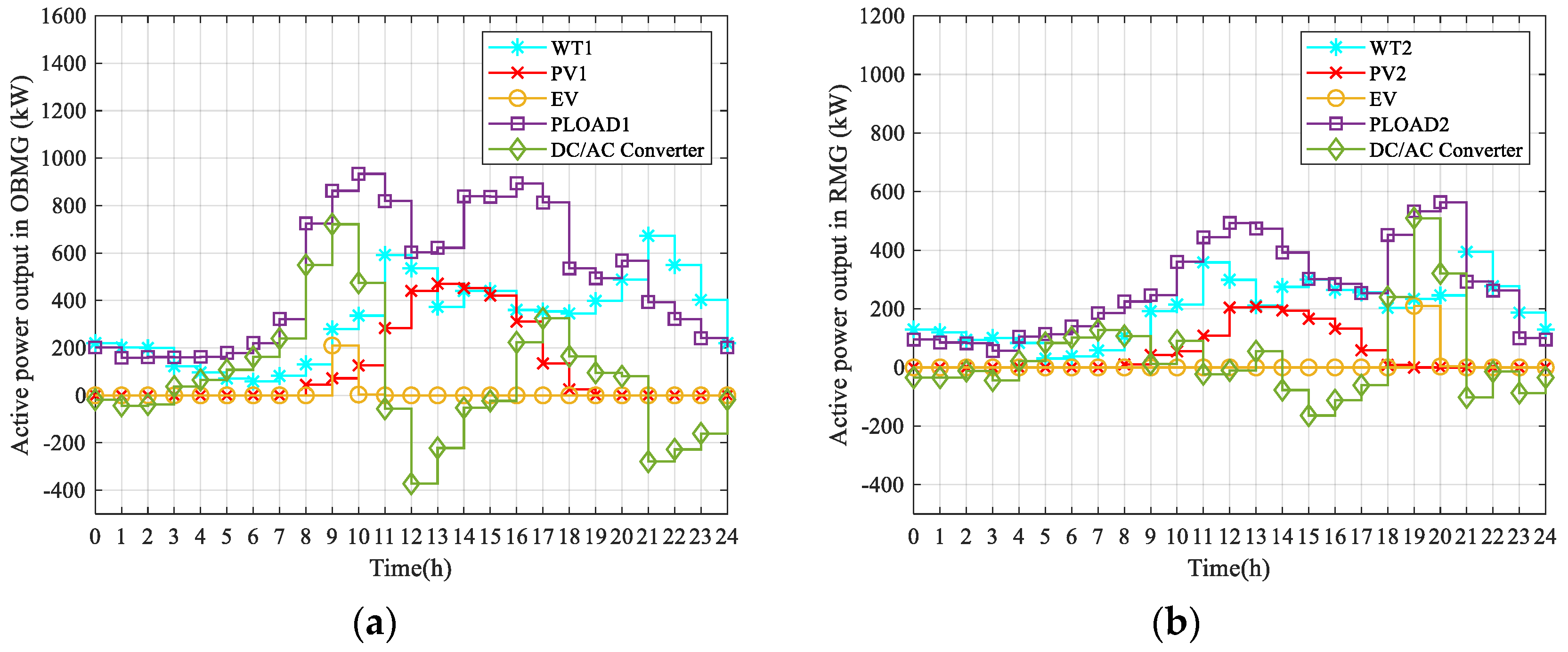



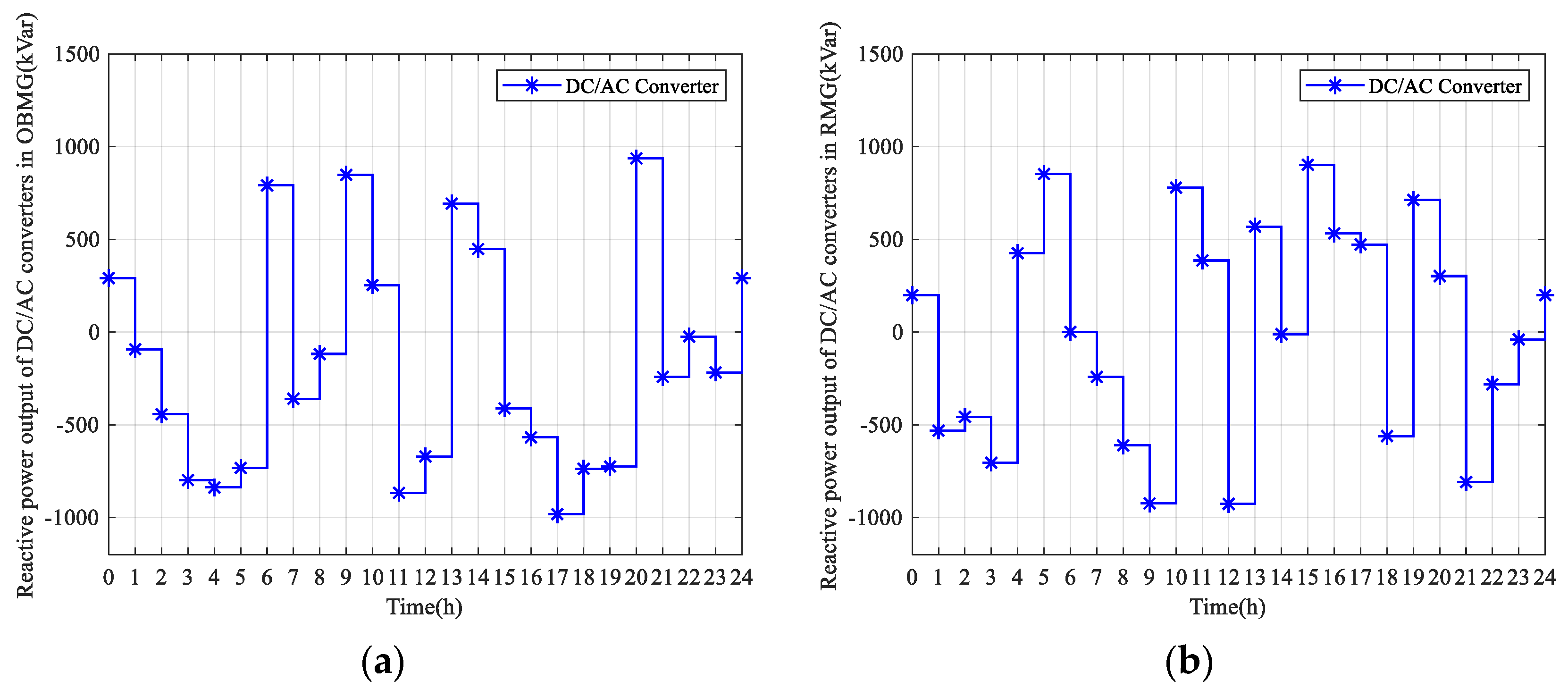
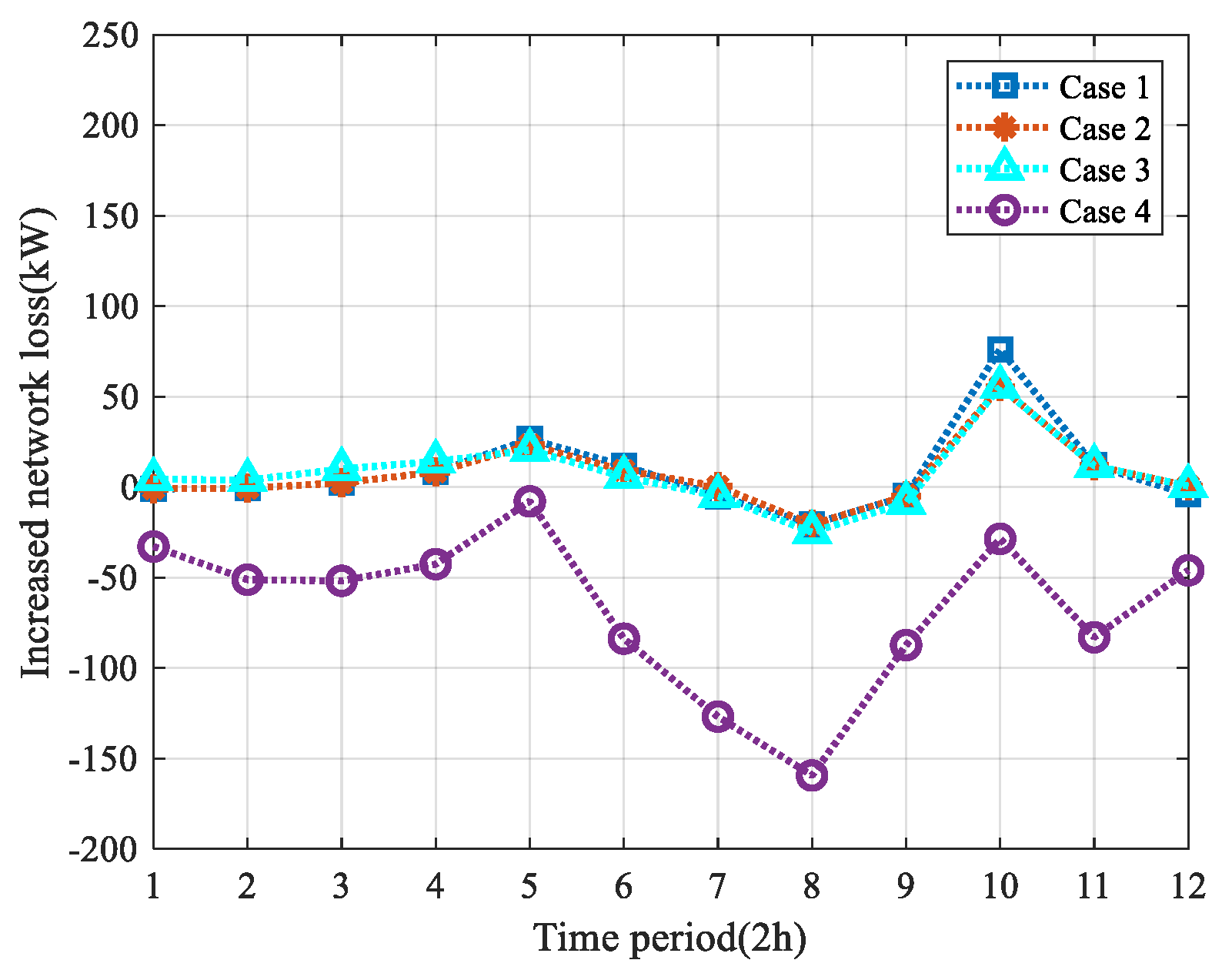
| MG Type | RES Type | Installed Capacity/kW | Power Generation Cost/¥·kWh−1 |
|---|---|---|---|
| OBMG | PV1 | 800 | 0.24 |
| WT1 | 800 | 0.38 | |
| RMG | PV2 | 400 | 0.24 |
| WT2 | 400 | 0.38 |
| Case | MGs | Cex Energy Transaction Cost/CNY | Cci Carbon Emissions Cost/CNY | COTC Total Operating Cost/CNY |
|---|---|---|---|---|
| Case 1 | RMG | 2760.0 | 16.3 | 2776.3 |
| OBMG | 5700.8 | 31.8 | 5732.6 | |
| MMGS | 8460.8 | 48.1 | 8508.9 | |
| Case 2 | RMG | 2627.8 | 16.3 | 2644.1 |
| OBMG | 5609.6 | 32.5 | 5642.1 | |
| MMGS | 8237.4 | 48.8 | 8286.2 | |
| Case 3 | RMG | 2348.9 | 42.9 | 2391.8 |
| OBMG | 5394.6 | 9.5 | 5404.1 | |
| MMGS | 7743.5 | 52.4 | 7795.9 |
| Case | Case 1 | Case 2 | Case 3 |
|---|---|---|---|
| The Cost of EVs’ Users/CNY | 211.2 | 173.4 | −410.8 |
| Case | Case 1 | Case 2 | Case 3 | Case 4 |
|---|---|---|---|---|
Total Network Loss/kW | 14,889.2 | 14,872.5 | 14,876.0 | 13,987.2 |
Increased Network Loss/kW | 101.3 | 84.6 | 88.1 | −800.7 |
| Case | Cil Network Loss Cost/CNY | Cco Carbon Emissions Cost/CNY | CWTC Energy Loss Cost/CNY |
|---|---|---|---|
| Case 1 | 75.0 | 1.8 | 76.8 |
| Case 2 | 62.6 | 1.5 | 64.1 |
| Case 3 | 65.2 | 1.6 | 66.8 |
| Case 4 | −592.5 | −14.5 | −607.0 |
| Case | Case 1 | Case 2 | Case 3 | Case 4 |
|---|---|---|---|---|
| CETC Total Economic Cost of MMGS/CNY | 8585.7 | 8350.3 | 7862.7 | 7188.9 |
| Case | Case 1 | Case 2 | Case 3 | Case 4 |
|---|---|---|---|---|
| EC Total Carbon Emissions/kg | 237.6 | 239.5 | 257.1 | 180.5 |
| Case | MGs | Cex Energy Transaction Cost/CNY | Cci Carbon Emissions Cost/CNY | COTC Total Operating Cost/CNY |
|---|---|---|---|---|
| Case 1 | RMG | 2968.9 | 23.4 | 2992.3 |
| OBMG | 6446.4 | 48.6 | 6495.0 | |
| MMGS | 9415.3 | 72.0 | 9487.3 | |
| Case 2 | RMG | 2836.7 | 23.4 | 2860.1 |
| OBMG | 6304.5 | 44.6 | 6349.1 | |
| MMGS | 9141.2 | 68.0 | 9209.2 | |
| Case 3 | RMG | 2574.4 | 48.5 | 2622.9 |
| OBMG | 6154.2 | 27.6 | 6181.8 | |
| MMGS | 8728.6 | 76.1 | 8804.7 |
| Case | Case 1 | Case 2 | Case 3 | Case 4 |
|---|---|---|---|---|
Total Network Loss/kW | 14,933.1 | 14,915.8 | 14,919.4 | 14,110.8 |
Increased Network Loss/kW | 145.2 | 127.9 | 131.5 | −677.1 |
| Case | Cil Network Loss Cost/CNY | Cco Carbon Emissions Cost/CNY | CWTC Energy Loss Cost/CNY |
|---|---|---|---|
| Case 1 | 107.4 | 2.6 | 110.0 |
| Case 2 | 94.6 | 2.3 | 96.9 |
| Case 3 | 97.3 | 2.4 | 99.7 |
| Case 4 | −501.1 | −12.3 | −513.4 |
| Case | Case 1 | Case 2 | Case 3 | Case 4 |
|---|---|---|---|---|
| CETC Total Economic Cost of MMGS/CNY | 9597.3 | 9306.1 | 8904.4 | 8291.3 |
Publisher’s Note: MDPI stays neutral with regard to jurisdictional claims in published maps and institutional affiliations. |
© 2021 by the authors. Licensee MDPI, Basel, Switzerland. This article is an open access article distributed under the terms and conditions of the Creative Commons Attribution (CC BY) license (https://creativecommons.org/licenses/by/4.0/).
Share and Cite
Xu, Z.; Chen, C.; Dong, M.; Zhang, J.; Han, D.; Chen, H. Cooperative Multi-Objective Optimization of DC Multi-Microgrid Systems in Distribution Networks. Appl. Sci. 2021, 11, 8916. https://doi.org/10.3390/app11198916
Xu Z, Chen C, Dong M, Zhang J, Han D, Chen H. Cooperative Multi-Objective Optimization of DC Multi-Microgrid Systems in Distribution Networks. Applied Sciences. 2021; 11(19):8916. https://doi.org/10.3390/app11198916
Chicago/Turabian StyleXu, Zhiwen, Changsong Chen, Mingyang Dong, Jingyue Zhang, Dongtong Han, and Haowen Chen. 2021. "Cooperative Multi-Objective Optimization of DC Multi-Microgrid Systems in Distribution Networks" Applied Sciences 11, no. 19: 8916. https://doi.org/10.3390/app11198916
APA StyleXu, Z., Chen, C., Dong, M., Zhang, J., Han, D., & Chen, H. (2021). Cooperative Multi-Objective Optimization of DC Multi-Microgrid Systems in Distribution Networks. Applied Sciences, 11(19), 8916. https://doi.org/10.3390/app11198916





